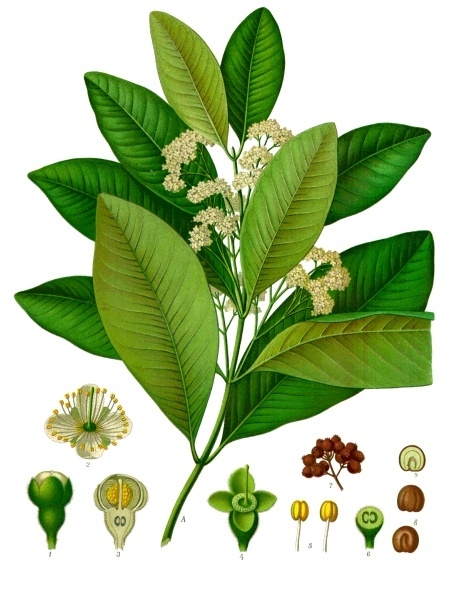Allspice
| style="background:#Template:Taxobox colour;"|Allspice | ||||||||||||||
|---|---|---|---|---|---|---|---|---|---|---|---|---|---|---|
 Allspice
| ||||||||||||||
| style="background:#Template:Taxobox colour;" | Scientific classification | ||||||||||||||
| ||||||||||||||
| Binomial name | ||||||||||||||
| Pimenta dioica (L.) Merr. |
|
WikiDoc Resources for Allspice |
|
Articles |
|---|
|
Most recent articles on Allspice |
|
Media |
|
Evidence Based Medicine |
|
Clinical Trials |
|
Ongoing Trials on Allspice at Clinical Trials.gov Clinical Trials on Allspice at Google
|
|
Guidelines / Policies / Govt |
|
US National Guidelines Clearinghouse on Allspice
|
|
Books |
|
News |
|
Commentary |
|
Definitions |
|
Patient Resources / Community |
|
Directions to Hospitals Treating Allspice Risk calculators and risk factors for Allspice
|
|
Healthcare Provider Resources |
|
Causes & Risk Factors for Allspice |
|
Continuing Medical Education (CME) |
|
International |
|
|
|
Business |
|
Experimental / Informatics |
Allspice, also called Jamaica pepper,"Kurundu" Myrtle pepper, pimento[1] , or newspice, is a spice which is the dried unripe fruit of the Pimenta dioica plant. The name "allspice" was coined by the English, who thought it combined the flavour of several aromatic spices, such as cinnamon, nutmeg, and cloves.
Preparation/Form
Ground allspice is not, as some people believe, a mixture of spices. Rather, it is the dried fruit of the Pimenta dioica plant. The fruit is picked when it is green and unripe and traditionally dried in the sun. When dry, the fruits are brown and resemble large brown peppercorns. The whole fruits have a longer shelf life than the powdered product and produce a more aromatic product when freshly ground before use.
The leaves of the allspice plant are also used in cooking. For cooking, fresh leaves are used where available: they are similar in texture to bay leaves and are thus infused during cooking and then removed before serving. Unlike bay leaves, they lose much flavour when dried and stored. The leaves and wood are often used for smoking meats where allspice is a local crop. Allspice can also be found in essential oil form.
Uses

Allspice is one of the most important ingredients of Caribbean cuisine. It is used in Caribbean jerk seasoning (the wood is used to smoke jerk in Jamaica, although the spice is a good substitute), in mole sauces, and in pickling; it is also an ingredient in commercial sausage preparations and curry powders. Allspice is also indispensable in Middle Eastern cuisine, particularly in the Levant where it is used to flavor a variety of stews and meat dishes. In Palestinian cuisine, for example, many main dishes call for allspice as the sole spice added for flavoring. In America, it is used mostly in desserts, but it is also responsible for giving Cincinnati-style chili its distinctive aroma and flavor as well. Allspice is commonly used in Great Britain and appears in many dishes, including in cakes. Even in many countries where allspice is not very popular in the household, such as Germany, it is used in large amounts by commercial sausage makers. Allspice is also a main flavor used in barbecue sauces. In the West Indies, an allspice liqueur called "pimento dram" is produced.
Allspice has also been used as a deodorant. Volatile oils found in the plant contain eugenol, a weak antimicrobial agent (Yaniv, Sohara et al. 2005). Allspice is also purported to provide relief for indigestion and gas[2].
Cultivation
Allspice is a small scrubby tree, quite similar to the bay laurel in size and form. It can be grown outdoors in the tropics and subtropics with normal garden soil and watering. Smaller plants can be killed by frost, although larger plants are more tolerant. It adapts well to container culture and can be kept as a houseplant or in a greenhouse. The plant is dioecious, meaning plants are either male or female and hence male and female plants must be kept in proximity in order to allow fruits to develop.
To protect the pimento trade the plant was guarded against export from Jamaica. It is reported that many attempts were made at growing the pimento from seeds, all failed. At one time it was thought that the plant would grow nowhere else except in Jamaica where the plant was readily spread by birds. Experiments were then performed using the constituents of bird droppings, however these were also totally unsuccessful. Eventually it was realized that an elevated temperature, such as that found inside a bird's body, was essential for germinating the seeds.
International naming
Пименто (Pimento) in Macedonian
References
Notes
- ↑ Note however, that the name pimento is also used for a certain kind of large, red, heart-shaped sweet pepper that measures three to four inches long and two to three inches wide. The flesh of this pimento is sweet, succulent and more aromatic than that of the red bell pepper. These pimentos are the familiar red stuffing found in quality green olives.
- ↑ The healing power of Spices; CBC
Works cited
- Herbs, Spices and Flavourings, Tom Stobart, Penguin books, 1977
- Yaniv, Zohara et al. Hand Book of Medicinal Plants. 10 Alice Street, Bringhamton, NY 13904-1580: Food Products Press(r), 2005.
External links
- Pimenta dioica at Floridata Plant Encyclopedia (an excellent reference)
- Pimenta dioica at The Herb Society of America
- Pimenta doica at Plants of Hawaii
- Allspice at Gernot Katzer's Spice Pages
- Allspice at Trade Winds Fruit
be:Ангельскае зелле be-x-old:Ангельскае зелле bg:Бахар cs:Pimentovník pravý da:Allehånde de:Piment eo:Pimento hsb:Wšědny korjenjownik is:Allrahanda it:Pimenta dioica hu:Szegfűbors nl:Piment no:Allehånde sl:Piment fi:Maustepippuri sv:Kryddpeppar to:Sipaisi